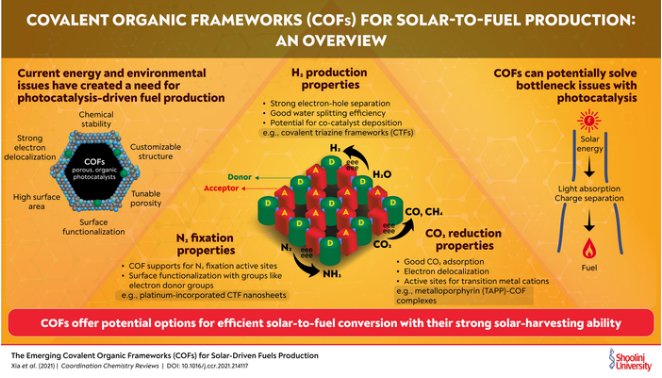Research on a new type of photocatalyst called a covalent organic framework (COF) has led to significantly increased hydrogen production rates in photocatalysts, which scientists at Shoonlini University said in a published Science Direct article could have implications for clean energy production in the future.
Photocatalysts are materials that absorb energy from light to perform a chemical reaction. Best known among photocatalysts is chlorophyll, a green pigment in plants that turns sunlight into carbohydrates.
In a photocatalytic reaction, light causes electrons to break their bonds and move freely through the catalyst. The excited electrons then react with the raw materials of a chemical reaction, and produce a desired end product.
A priority by the alternative energy research field is to use photocatalysts to convert solar energy into fuel, a process called “solar-to-fuel production.”
The current performance of these materials has been limited due to poor light absorption, fast photogenerated electron-hole recombination, and inappropriate active sites. However, the development of COFs has worked to address some of these limitations.
COFs are able to add special molecules called “functional groups” to their structure, which provide a way around some of the limitations of traditional photocatalysts. COFs have higher chemical stability, controllable porosity, and strong electron delocalization, which makes them extra stable.
Strong electron delocalization means that unlike in semiconductor catalysts, excited electrons recombine midway infrequently, leading to more excited electrons for the chemical reaction.
COFs consist of organic molecules, and can be tailored to suit various applications. The modifiable porosity and stability of the material make it particularly well suited for fuel production, as well as in carbon dioxide conversion.
The researchers said COFs have the ability to convert CO2 into methane gas, providing a dual benefit of fuel production and carbon reduction. COFs can also be used in nitrogen fixation processes, plastics production, and the storage of gases.
A new class of COF, covalent triazine frameworks (CTF) are currently at the cutting edge of hydrogen production research. This new material has been shown to produce 20-50 times the hydrogen that traditional graphitic photocatalysts make, making it a potential option for future fuel production.
COF-based photocatalysts are still in an early stage of development, and at this time do not produce power as efficiently as semiconductors. However, their unique properties and diversity of structure make them promising candidates for future solar-to-fuel research.






